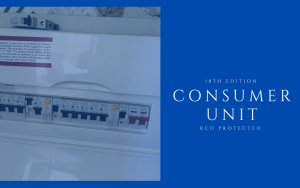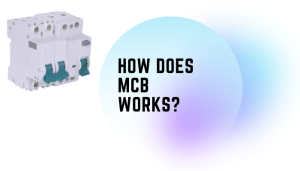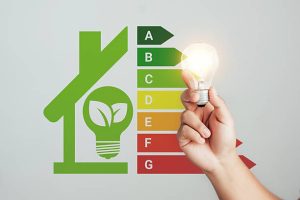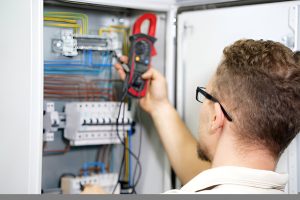Book Electrical Installation Condition Report EICR services to ensure the safety and compliance of your property’s electrical systems. This vital assessment checks wiring integrity, identifies potential hazards, and guarantees adherence to IET Wiring Regulations. Regular inspections—recommended every ten years for residential properties—enhance system longevity and help mitigate costly repairs. Choosing a qualified professional is essential for accurate reporting. Exploring the EICR process further will offer deeper insights into maintaining optimal electrical safety and compliance.
Key Takeaways
- Research qualified professionals who are certified to conduct EICR assessments to ensure compliance with safety standards.
- Schedule the EICR during off-peak hours to minimize disruption and provide optimal access to all areas of the property.
- Obtain detailed quotes from multiple service providers to understand pricing based on property size and complexity.
- Ensure the selected professional offers comprehensive services covering all electrical safety and compliance aspects.
- Regularly book EICR assessments every ten years for residential properties to maintain safety and adhere to regulatory obligations.
Understanding the Electrical Installation Condition Report (EICR)
An Electrical Installation Condition Report (EICR) serves as a thorough assessment of an electrical system’s safety and compliance with current regulations.
EICR basics encompass the systematic evaluation of wiring, fixtures, and overall installation integrity. This document identifies potential hazards, ensuring that the electrical installation meets the standards set forth by the IET Wiring Regulations.

The inspection frequency is pivotal; typically, a residential EICR should be conducted every ten years, while commercial properties may require more frequent assessments based on usage and risk factors.
Inspection frequency is crucial; residential EICRs are recommended every ten years, while commercial assessments may vary based on usage and risk.
Adhering to these guidelines enhances safety and mitigates the risks associated with electrical installations.
Importance of Regular EICR Assessments
Regular EICR assessments are essential for ensuring safety compliance within electrical installations, as they identify potential hazards and confirm adherence to current regulations.
Additionally, these assessments facilitate preventive maintenance, allowing for timely interventions that can mitigate costly repairs and enhance system longevity.
Consequently, routine evaluations serve as both a safety measure and a strategic maintenance practice.
Safety Compliance Assurance
Ensuring safety compliance in electrical installations is paramount for both residential and commercial properties.
Regular Electrical Installation Condition Report (EICR) assessments are critical for verifying adherence to established safety standards. These compliance checks identify potential hazards, ensuring that installations meet legal obligations and industry best practices.
Additionally, a systematic approach to EICR evaluations enhances risk management strategies, mitigating the likelihood of electrical failures. This proactive measure not only safeguards occupants but also preserves the integrity of electrical systems.
Ultimately, compliance with safety standards fosters trust and reliability, affirming the commitment to maintaining a safe and efficient electrical environment.
Preventive Maintenance Benefits
Periodic assessments through Electrical Installation Condition Reports (EICR) serve as a fundamental aspect of preventive maintenance in electrical systems.
Implementing such preventive strategies enhances system reliability and extends equipment lifespan. Regular EICR assessments identify potential hazards and compliance issues, enabling timely corrective actions that mitigate risks.
Establishing structured maintenance schedules guarantees that inspections occur consistently, preventing unexpected failures and minimizing downtime.
In addition, adherence to EICR guidelines fosters a culture of safety, promoting operational efficiency across electrical installations.
Ultimately, the integration of EICR into maintenance protocols is essential for safeguarding assets and guaranteeing long-term performance in complex electrical infrastructures.
Key Components of an EICR
The Electrical Installation Condition Report (EICR) encompasses several critical components that collectively assess the safety and functionality of electrical installations.
The EICR evaluates essential aspects of electrical installations to ensure safety and operational effectiveness.
Central to this report are the eicr documentation standards, which dictate the format and content necessary for compliance and clarity.
EICR testing methods, including visual inspections and testing of circuits, guarantee that installations meet required safety thresholds and operational efficacy.
Additionally, the findings are categorized into observations that detail any deficiencies or recommendations for remedial action.
Collectively, these elements provide a thorough overview, facilitating informed decision-making regarding electrical safety and maintenance within a property.
What to Expect During an EICR Inspection
During an EICR inspection, property owners can expect a thorough evaluation of their electrical systems to verify safety and compliance with established standards.
The inspection process involves a detailed analysis of the electrical installations, utilizing an EICR checklist to assess various components such as wiring, circuit breakers, and safety devices.
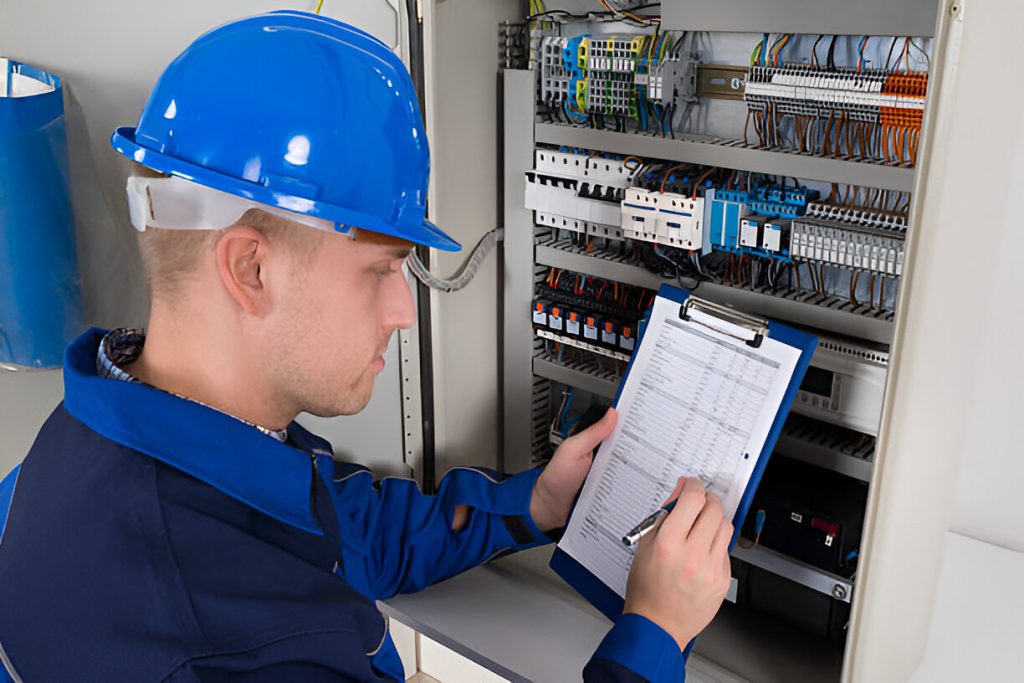
Qualified inspectors systematically examine each aspect, confirming that all installations adhere to current regulations.
The findings will culminate in a formal report, highlighting any non-compliance issues or potential hazards.
This meticulous approach guarantees that property owners are informed about the integrity and safety of their electrical systems, promoting long-term functionality.
Common Issues Detected in EICR Assessments
EICR assessments frequently reveal critical deficiencies in electrical installations.
Common issues include wiring wear and tear, which compromises safety and efficiency, circuit overload scenarios that can lead to failures, and inadequate earthing systems that increase the risk of electric shock.
Addressing these concerns is essential for ensuring compliance and safeguarding users.
Wiring Wear and Tear
As electrical systems age, various forms of wear and tear become evident, prompting the need for thorough assessments such as the Electrical Installation Condition Report (EICR).
A critical focus is on wiring lifespan, which can be greatly reduced by factors such as insulation degradation. This degradation manifests through brittle or cracked insulation, leading to potential exposure of conductive materials.
Additionally, mechanical wear, environmental influences, and thermal stress contribute to overall deterioration.
Regular EICR evaluations are essential to identify these issues, ensuring that the integrity of the electrical system is maintained and minimizing the risk of hazards associated with aged wiring.
Circuit Overload Issues
Circuit overload issues frequently arise in electrical systems, particularly when demand exceeds the capacity of the circuit. Such conditions lead to excessive heat generation, which can compromise insulation integrity and elevate fire risks.
EICR assessments often reveal instances where circuits are either inadequately rated for connected loads or burdened by multiple high-draw devices. Effective overload prevention strategies include the proper sizing of circuit breakers, installation of residual current devices (RCDs), and adherence to load calculations.
Inadequate Earthing Systems
Inadequate earthing systems present significant risks within electrical installations, particularly when the grounding mechanisms fail to provide a reliable path for fault currents. Such deficiencies can result in severe safety hazards and operational inefficiencies.
Common issues identified in EICR assessments include:
- Increased risk of electrical shock
- Potential for equipment damage
- Compromised fire safety
- Regulatory non-compliance
Addressing these vulnerabilities necessitates a thorough understanding of earthing systems and effective grounding techniques.
Regular assessments and timely corrective actions are essential to guarantee the integrity and safety of electrical installations, thereby safeguarding both personnel and property from preventable incidents.
EICR Compliance and Regulations
Compliance with Electrical Installation Condition Report (EICR) regulations is essential for guaranteeing the safety and reliability of electrical systems.
Adhering to EICR legalities mandates that electrical installations undergo regular assessments to align with established EICR standards. These standards delineate the minimum requirements for safe operation, addressing potential hazards that could compromise system integrity.
Failure to comply can result in legal ramifications and safety risks, underscoring the importance of understanding and implementing these regulations.
Therefore, a thorough grasp of EICR compliance not only fosters enhanced safety but also guarantees adherence to statutory obligations, promoting responsible electrical system management.
How to Choose a Qualified EICR Professional
Selecting a qualified professional for conducting an Electrical Installation Condition Report (EICR) is imperative for guaranteeing the accuracy and reliability of the assessment process.
Key factors to take into account include:
- Certification verification to confirm qualifications and adherence to industry standards.
- Experience evaluation to assess the professional’s historical performance and expertise in EICR assessments.
- Client testimonials that reflect reliability and trustworthiness in service.
- Comprehensive service offerings to guarantee all aspects of electrical safety are covered.
Rigorous scrutiny of these elements fosters confidence in the EICR, ultimately safeguarding both property and inhabitants from potential electrical hazards.
Scheduling and Costs of EICR Services
When planning an Electrical Installation Condition Report (EICR), careful consideration of scheduling and associated costs is essential to guarantee a seamless process.
EICR scheduling should align with operational demands and regulatory requirements, ensuring minimal disruption. Professionals often recommend booking EICR assessments during off-peak hours to facilitate efficient inspections.
EICR pricing varies based on factors such as property size, complexity, and geographical location. Homeowners and businesses must obtain detailed quotes to understand the financial implications fully.
Additionally, budgeting for potential remedial work identified during the EICR can prevent unforeseen expenditures, emphasizing the importance of thorough planning in the EICR process.



